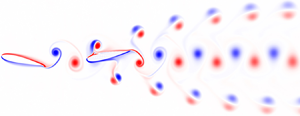Crossref Citations
This article has been cited by the following publications. This list is generated based on data provided by
Crossref.
Gungor, Ahmet
Khalid, Muhammad Saif Ullah
and
Hemmati, Arman
2021.
How does switching synchronization of pitching parallel foils from out-of-phase to in-phase change their wake dynamics?.
Physics of Fluids,
Vol. 33,
Issue. 8,
Joshi, Vaibhav
and
Mysa, Ravi Chaithanya
2021.
Mechanism of wake-induced flow dynamics in tandem flapping foils: Effect of the chord and gap ratios on propulsion.
Physics of Fluids,
Vol. 33,
Issue. 8,
Gungor, Ahmet
and
Hemmati, Arman
2021.
The scaling and performance of side-by-side pitching hydrofoils.
Journal of Fluids and Structures,
Vol. 104,
Issue. ,
p.
103320.
Zhang, Yiping
and
Xu, Li
2021.
A propulsion unit for ships based on water-treading of flapping foils.
Ocean Engineering,
Vol. 235,
Issue. ,
p.
109330.
Wang, Guangjian
Ng, Bing Feng
Teo, Zhen Wei
Lua, Kim Boon
and
Bao, Yan
2021.
Performance augmentation mechanism of tandem flapping foils with stroke time-asymmetry.
Aerospace Science and Technology,
Vol. 117,
Issue. ,
p.
106939.
Swain, Prafulla Kumar
Barik, Ashok K.
Dora, Siva Prasad
and
Resapu, Rajeswara
2022.
The propulsion of tandem flapping foil following fishtailed flapping trajectory.
Physics of Fluids,
Vol. 34,
Issue. 12,
Lu, Jiaxin
Lu, Yang
Ma, Jinchao
and
Wang, Junjie
2022.
Numerical investigation of the wake transition and aerodynamic efficiency of the two-dimensional propulsive wing.
AIP Advances,
Vol. 12,
Issue. 12,
Lawson, Nicholas J.
Davies, Simon G.
Khanal, Bidur
and
Hoff, Rein I.
2022.
Wake-Tailplane Interaction of a Slingsby Firefly Aircraft.
Aerospace,
Vol. 9,
Issue. 12,
p.
787.
Bie, Dawei
and
Li, Daochun
2022.
Numerical analysis of the wing–wake interaction of tandem flapping wings in forward flight.
Aerospace Science and Technology,
Vol. 121,
Issue. ,
p.
107389.
Wu, Jianghao
Li, Gang
Chen, Long
and
Zhang, Yanlai
2022.
Unsteady aerodynamic performance of a tandem flapping–fixed airfoil configuration at low Reynolds number.
Physics of Fluids,
Vol. 34,
Issue. 11,
Zhang, Dong
Zhang, Jun-Duo
and
Huang, Wei-Xi
2022.
Physical models and vortex dynamics of swimming and flying: a review.
Acta Mechanica,
Vol. 233,
Issue. 4,
p.
1249.
Gungor, Ahmet
Khalid, Muhammad Saif Ullah
and
Hemmati, Arman
2022.
Classification of vortex patterns of oscillating foils in side-by-side configurations.
Journal of Fluid Mechanics,
Vol. 951,
Issue. ,
Alam, Md. Mahbub
2022.
Schooling Benefits from a System of Active and Passive Hydrofoils.
SSRN Electronic Journal ,
Lin, Xingjian
Wu, Jie
Yang, Liming
and
Dong, Hao
2022.
Two-dimensional hydrodynamic schooling of two flapping swimmers initially in tandem formation.
Journal of Fluid Mechanics,
Vol. 941,
Issue. ,
Chao, Li-Ming
Bhalla, Amneet Pal Singh
and
Li, Liang
2023.
Vortex interactions of two burst-and-coast swimmers in a side-by-side arrangement.
Theoretical and Computational Fluid Dynamics,
Vol. 37,
Issue. 4,
p.
505.
Lagopoulos, N. S.
Weymouth, G. D.
and
Ganapathisubramani, B.
2023.
Effect of aspect ratio on the propulsive performance of tandem flapping foils.
Flow,
Vol. 3,
Issue. ,
Baddoo, Peter J.
Moore, Nicholas J.
Oza, Anand U.
and
Crowdy, Darren G.
2023.
Generalization of waving‐plate theory to multiple interacting swimmers.
Communications on Pure and Applied Mathematics,
Vol. 76,
Issue. 12,
p.
3811.
Smyth, A. S. M.
Young, A. M.
and
Di Mare, L.
2023.
Generating high-efficiency swimming kinematics using hydrodynamic eigenmode decomposition.
Physics of Fluids,
Vol. 35,
Issue. 8,
Anilir, Berkan
Kurtulus, Dilek F.
and
Platzer, Max
2023.
Aerodynamics of Close-coupled Stationary/Flapping Tandem NACA 0012 Airfoils.
Ji, Tingwei
Jin, Fan
Zheng, Hongyu
Zhang, Xinshuai
Xie, Fangfang
and
Zheng, Yao
2023.
Intelligent perception of tandem flapping wings' flow field environment with sparse detectors.
Physics of Fluids,
Vol. 35,
Issue. 10,
